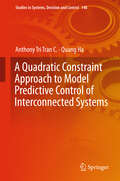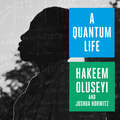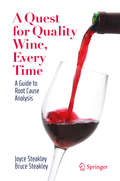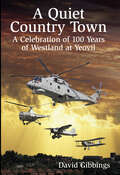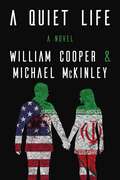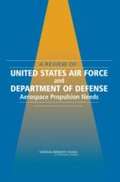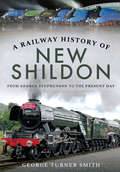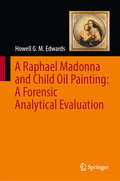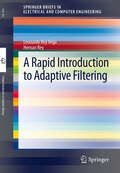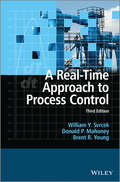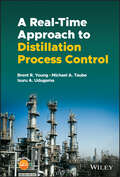- Table View
- List View
A Quadratic Constraint Approach to Model Predictive Control of Interconnected Systems (Studies In Systems, Decision And Control #148)
by Anthony Tri Tran C. Quang HaThis book focuses on the stabilization and model predictive control of interconnected systems with mixed connection configurations. It introduces the concept of dissipation-based quadratic constraint for developing attractivity assurance methods for interconnected systems. In order to develop these methods, distributed and decentralized architectures are employed, whereby the communication between subsystems is fully connected, partially connected, or completely disconnected. Given that the control inputs are entirely or partially decoupled between subsystems and no additional constraints are imposed on the interactive variables beyond the coupling constraint itself, the proposed approaches can be used with various types of systems and applications. Further, the book describes how the effects of coupling delays and data losses in device networks are resolved. From a practical perspective, the innovations presented are of benefit in applications in a broad range of fields, including the process and manufacturing industries, networked robotics, and network-centric systems such as chemical process systems, power systems, telecommunication networks, transportation networks, and, no less importantly, supply chain automation.
A Quantum Life: My Unlikely Journey from the Street to the Stars
by Joshua Horwitz Hakeem OluseyiIn this inspiring coming-of-age memoir, a world-renowned astrophysicist emerges from an impoverished childhood and crime-filled adolescence to ascend through the top ranks of research physics.Navigating poverty, violence, and instability, a young James Plummer had two guiding stars-a genius IQ and a love of science. But a bookish nerd was a soft target in his community, where James faced years of bullying and abuse. As he struggled to survive his childhood in some of the country's toughest urban neighborhoods in New Orleans, Houston, and LA, and later in the equally poor backwoods of Mississippi, he adopted the persona of "gangsta nerd"-dealing weed in juke joints while winning state science fairs with computer programs that model Einstein's theory of relativity. Once admitted to the elite physics PhD program at Stanford University, James found himself pulled between the promise of a bright future and a dangerous crack cocaine habit he developed in college. With the encouragement of his mentor and the sole Black professor in the physics department, James confronted his personal demons as well as the entrenched racism and classism of the scientific establishment. When he finally seized his dream of a life in astrophysics, he adopted a new name, Hakeem Muata Oluseyi, to honor his African ancestors.Alternately heartbreaking and hopeful, A QUANTUM LIFE narrates one man's remarkable quest across an ever-expanding universe filled with entanglement and choice.
A Quantum Life: My Unlikely Journey from the Street to the Stars
by Joshua Horwitz Hakeem OluseyiIn this inspiring coming-of-age memoir, a world-renowned astrophysicist emerges from an impoverished childhood and crime-filled adolescence to ascend through the top ranks of research physics.Navigating poverty, violence, and instability, a young James Plummer had two guiding stars-a genius IQ and a love of science. But a bookish nerd was a soft target in his community, where James faced years of bullying and abuse. As he struggled to survive his childhood in some of the country's toughest urban neighborhoods in New Orleans, Houston, and LA, and later in the equally poor backwoods of Mississippi, he adopted the persona of "gangsta nerd"-dealing weed in juke joints while winning state science fairs with computer programs that model Einstein's theory of relativity. Once admitted to the elite physics PhD program at Stanford University, James found himself pulled between the promise of a bright future and a dangerous crack cocaine habit he developed in college. With the encouragement of his mentor and the sole Black professor in the physics department, James confronted his personal demons as well as the entrenched racism and classism of the scientific establishment. When he finally seized his dream of a life in astrophysics, he adopted a new name, Hakeem Muata Oluseyi, to honor his African ancestors.Alternately heartbreaking and hopeful, A QUANTUM LIFE narrates one man's remarkable quest across an ever-expanding universe filled with entanglement and choice.
A Quest for Quality Wine, Every Time.: A Guide for Root Cause Analysis.
by Joyce Steakley Bruce SteakleyWine has been around for thousands of years, grape growing and wine production is worldwide, and recipes are prolific. However, this approach to winemaking root cause analysis is original and cannot be found in any other winemaking publications. The book start with the basics, with the authors' own basic winemaking steps. This provides a winemaking process and common language. With this understanding and departure point, they describe Root Cause Analysis (RCA) methods as applied to winemaking. Though winemaking appears to have simple steps, problems or flaws inevitably arise. Instant access to online materials can provide ad-hoc answers to given conditions; however, the applicability of these solutions to one’s own situation ad particular conditions is not always clear. Selective changes may or may not solve the problem and in the winemaking world, it may take years to finish the wine and understand if the quality actually improved or not. A finished wine will have thousands of particular current and historical conditions that played some role in its quality.The root cause analysis (RCA) approach provides a path to sort these out and guide winemakers to the solution. It creates a problem statement and systematically divides the world into six discrete groups. This book tackles each and all of these, one group at a time. The text contains examples that prioritize the contributing factors. Observations are noted, possibilities identified, and likelihoods assessed. Actions and tests are identified to aid in assigning risk, corrective action, and preventive measures. Given limited time and resources, prioritized risks and actions improve the chance of solving the problem. The book provides problems exploring each of their respective six group characteristics. Each RCA step is described and illustrated in detail. The process is revealed and explained through multiple examples. Feature 1: Organized systematic method for solving winemaking quality problemsFeature 2: Applicable to amateur or commercial winemakers or any other product or system development activity and organization Feature 3: Unique new application to the wine making world but similar methods historically used in complex aerospace product development Feature 4: Teaching winemakers and producers how to think about uncertainty and error. It’s possible that gold medal wine, or 95-point Wine Spectator score, or 93-point Robert Parker score was deserved for that particular wine and vintage. But it is also possible you were very lucky. It may not be earned again in next year’s vintage. This book teaches approaches and methods to maintain and or improve the quality, every year. Feature 5: Application of a potentially 'dry' rigorous root cause analysis approach in a world that enables the joy of creating and appreciating something very enjoyable. It will help you smile, at least once a year.
A Quiet Country Town: A Celebration of Westland at Yeovil
by David Gibbings‘an excellent read’ AEROSPACE magazineIn 1915, Westland Aircraft Works was established in the country town of Yeovil. Since then, aircraft have been designed, manufactured and tested at Westland, including the Lysander, which was used to transport British agents to Europe during the Second World War. In 1948, the company focused solely on helicopters and its aircraft have been sent all over the world since then, used in life-saving with Air Ambulance and Search and Rescue, and deployed in warfare such as Balkans, Iraq and Afghanistan.In this new and updated edition of A Quiet Country Town, David Gibbings celebrates over 100 years of Westland through an anthology of writings that retell the company’s history and its special relationship with Yeovil, which has rarely been quiet since the first aircraft took off from the airfield that now lies at its heart.
A Quiet Life: A Novel
by William Cooper Michael McKinleyIt was just a link in an email. Michael Housen is living a typical, white-collar American life at a security company when he falls for a phishing campaign with dire implications. One click, and suddenly the US is under marshal law and bombing Tehran. Michael unknowingly triggered a cyberattack by Iranian hackers, which a belligerent President Davis uses as pretext for war against Iran. Michael blinks and he and his wife, Pam, are thrown into private prisons owned by the president, a multibillionaire tycoon. This ordinary couple suddenly must answer a harrowing question: What do you do when the enemy of the state is you? And they find themselves cooperating with extraordinary partners, from right-wing militias to Iranian documentarians, as they work to clear their names and stop the global conflict that Michael set off with an unwitting click. Written by a renowned cybersecurity attorney and a bestselling author, A Quiet Life is a cyberthriller for the times that we all live in, and how we can lose everything on the strength of a lie. And how once we start fighting back, we cannot stop.
A REVIEW OF UNITED STATES AIR FORCE and DEPARTMENT OF DEFENSE Aerospace Propulsion Needs
by National Research Council of the National AcademiesThe National Academies Press (NAP)--publisher for the National Academies--publishes more than 200 books a year offering the most authoritative views, definitive information, and groundbreaking recommendations on a wide range of topics in science, engineering, and health. Our books are unique in that they are authored by the nation's leading experts in every scientific field.
A Railway History of New Shildon: From George Stephenson to the Present Day
by George Turner SmithAn &“extraordinarily informative and profusely illustrated&” history of how a town built a railway, and a railway built a town (Midwest Book Review). On September 27, 1825, the first public railway steam train left New Shildon for Stockton-on-Tees, England. The driver was George Stephenson and the engine he was driving was the &“Locomotion No.1.&” It set off from a settlement that consisted of just a set of rails and four houses, none of which had been there a year before. The four houses became a town with a five-figure population, a town that owed its existence to the railway that made its home there—the Stockton and Darlington (S&DR). Some of the earliest and greatest railway pioneers worked there, including George and his son Robert; the Hackworth brothers, Timothy and Thomas; and the engineer William Bouch. Their story is part of New Shildon&’s story. The locomotive works, created to build and maintain steam locomotives, morphed into the world&’s most innovative works, whose demise had more to do with politics than productivity. This book covers Shildon&’s years between 1820 and today, including the war interludes when the Wagon Works was manned by women and the output was mostly intended for the Ministry of Defense. The story of the creation of the town&’s railway museum and the arrival of Hitachi at Newton Aycliffe brings the history up to date and, to complete the picture, there is also a description of the ongoing new build G5 steam locomotive project on Hackworth Industrial Estate, the very site where the S&DR locomotive and wagon works was located. It is the story of a railway town—and also the story of the people who lived there and made it what it is today.
A Raphael Madonna and Child Oil Painting: A Forensic Analytical Evaluation
by Howell G. EdwardsThis book presents a comprehensive forensic analysis of an oil painting depicting a Madonna and Child in a tondo format, previously thought to be a Victorian copy. Detailed historical and scientific studies confirm that this painting was, in fact, created by Raphael around 1512 as a study for his renowned Sistine Madonna, commissioned by Pope Julius II as an altarpiece for the monastic church of San Sisto in Piacenza. The painting underwent rigorous forensic examination, combining historical research with both invasive and non-invasive scientific imaging techniques. The analysis utilized advanced physical and chemical instrumentation to determine the painting's authenticity and accurate chronological placement. A comparative review of published chemical analyses of pigments, dyes, and substrates used in Raphael’s works from collections worldwide is included. Additionally, this study explores the innovative use of artificial intelligence (AI) for facial comparison between the figures in the tondo painting, the Sistine Madonna, and other Raphael artworks. These AI-generated insights provide novel information about the identities of Raphael’s models and shed light on his working techniques, as well as those of his associates.
A Rapid Introduction to Adaptive Filtering (SpringerBriefs in Electrical and Computer Engineering)
by Hernan Rey Leonardo Rey VegaIn this book, the authors provide insights into the basics of adaptive filtering, which are particularly useful for students taking their first steps into this field. They start by studying the problem of minimum mean-square-error filtering, i.e., Wiener filtering. Then, they analyze iterative methods for solving the optimization problem, e.g., the Method of Steepest Descent. By proposing stochastic approximations, several basic adaptive algorithms are derived, including Least Mean Squares (LMS), Normalized Least Mean Squares (NLMS) and Sign-error algorithms. The authors provide a general framework to study the stability and steady-state performance of these algorithms. The affine Projection Algorithm (APA) which provides faster convergence at the expense of computational complexity (although fast implementations can be used) is also presented. In addition, the Least Squares (LS) method and its recursive version (RLS), including fast implementations are discussed. The book closes with the discussion of several topics of interest in the adaptive filtering field.
A Real-Time Approach to Process Control
by Donald P. Mahoney William Y. Svrcek Brent R. YoungWith resources at a premium, and ecological concerns paramount, the need for clean, efficient and low-cost processes is one of the most critical challenges facing chemical engineers. The ability to control these processes, optimizing one, two or several variables has the potential to make more substantial savings in time, money and resources than any other single factor. Building on the success of the previous editions, this new third edition of A Real-Time Approach to Process Control employs both real industry practice and process control education without the use of complex or highly mathematical techniques, providing a more practical and applied approach.Updated throughout, this edition:* Includes a brand new chapter on Model predictive Control (MPC)* Now includes wireless and web-based technologies* Covers bio-related systems* Details the new multivariable control measure developed by the authors* Includes PowerPoint slides and solutions to Workshop problems on the accompanying website: http://www.wiley.com/go/svrcek-real-time-3e From the reviews of previous editions:"Would appeal to practising engineers due to its "hands on" feel for the subject matter. But more importantly, the authors present these concepts as fundamentals of chemical engineering, in a way that is consistent with how professor teach at the universities." -Chemical Engineering Process (CEP)"The book has been beautifully crafted" -Engineering Subject Centre"Provides a refreshing approach to the presentation of process analysis and control" -The Chemical Engineer
A Real-time Approach to Distillation Process Control
by Brent R. Young Michael A. Taube Isuru A. UdugamaA Real-Time Approach to Distillation Process Control A practical and hands-on discussion of modern distillation control In A Real-time Approach to Distillation Process Control, a team of distinguished researchers and industrial practitioners delivers a practical text combining hands-on and active learning using process simulation with discussions of the fundamental knowledge and tools required to apply modern distillation control principles. The book offers a balanced, real-time approach integrated with practical insights. It includes many exercises designed to be simulator agnostic that can be performed on the process simulator locally available to the reader. Readers will discover explorations of topics including distillation control hardware, distillation composition control, refinery versus chemical plant distillation control, distillation control tuning, advanced regulatory control, and more. They’ll also find: A thorough introduction to distillation fundamentals, as well as basic and advanced modern controls from a practical point of view Comprehensive explorations of known base controls combined with modern control practices Practical discussions of hands-on modelling and simulation exercises, allowing the reader to design and tune controls on a distillation column Fulsome treatments of control structure design integrated with controller tuning using a real-time approach Perfect for senior undergraduate and graduate students studying general process control or distillation process control, A Real-time Approach to Distillation Process Control will also benefit plant managers, production supervisors, startup supervisors, operations engineers, production engineers, and chemical engineers working in industry.
A Reference Architecture for Real-Time Performance Measurement: An Approach to Monitor and Control Manufacturing Processes (Progress in IS)
by Sachin KaradgiThis book describes how manufacturing enterprises, by reinforcing their existing monitoring and control of manufacturing processes, can successfully face the ever-increasing pressure from internal and external environments to maintain their competitive advantage. Numerous performance measurement systems have been elaborated to satisfy these requirements, stressing the importance of financial and operational metrics. It also highlights the fact that research on generating and linking financial and operational metrics, especially in real-time, has not garnered sufficient attention to date. The book follows an approach that integrates enterprises across different levels and departments. By computing and linking the financial and operational metrics in real-time, the book demonstrates how to provide a comprehensive view of an entire enterprise.
A Region in Transition: North East England at the Millennium (Urban and Regional Planning and Development Series)
by John Tomaney Neil WardThe UK has now joined a Europe-wide trend towards more devolved forms of government (e.g. Scotland, Wales and Northern Ireland Assemblies). In the context of this general trend towards regionalizm as a focus for public policy and as a source of cultural and political identity, an interdisciplinary team from Newcastle University combine to analyze how this affects the North East of England. There has been comparatively little published on the contemporary development of English Regions and the North East is a particularly important case study, as throughout the 1990s it has experienced a range of social, economic and political changes. This book will contribute to key contemporary policy debates, which will affect all of the English regions and should be read by all social scientists interested in European regional development.
A Remote Integrated Testbed for Cooperating Objects (SpringerBriefs in Electrical and Computer Engineering)
by Jose Ramiro Martinez-de Dios Adrian Jimenez-Gonzalez Alberto San Bernabe Anibal OlleroTestbeds are gaining increasing relevance in research domains and also in industrial applications. However, very few books devoted to testbeds have been published. To the best of my knowledge no book on this topic has been published. This book is particularly interesting for the growing community of testbed developers. I believe the book is also very interesting for researchers in robot-WSN cooperation. This book provides detailed description of a system that can be considered the first testbed that allows full peer-to-peer interoperability between heterogeneous robots and ubiquitous systems such as Wireless Sensor Networks, camera networks and pervasive computing systems. The system architecture includes modules that allows full bidirectional communication between robots and WSN. One robot can The book describes the current state of the art in development of testbeds integrating Cooperating Object technologies. It describes in detail the testbed specification and design using requirements extracted from surveys among experts in robotics and ubiquitous systems in academia and industry. The book also describes the testbed novel architecture and its hardware and software components. Moreover, it includes details on user support tools to facilitate its use such as remote use using a virtual private network and sets of functionalities of interest for members from the robotics, WSN and robot-WSN communities. Finally, the book illustrates its capabilities and potentialities describing the implementation of some of the experiments that have been performed. Examples from the robotics, WSN and robot-WSN communities are described.
A Research Agenda for Geographic Information Science
by E. Lynn Usery Robert B. McMasterA close relationship exists between GIS and numerous applications, including cartography, photogrammetry, geodesy, surveying, computer and information science, and statistics, among others. Scientists coined the term "geographic information science (GIScience)" to describe the theory behind these fields. A Research Agenda for Geographic Information
A Research Primer for Technical Communication: Methods, Exemplars, and Analyses
by Pam Estes Brewer George F HayhoeThis fully revised edition provides a practical introduction to research methods for anyone conducting and critically reading technical communication research. The first section discusses the role of research in technical communication and explains in plain language how to conduct and report such research. It covers both quantitative and qualitative methods, as well as surveys, usability studies, and literature reviews. The second section presents a collection of research articles that serve as exemplars of these major types of research projects, each followed by commentary breaking down how it corresponds to the information on that research type. In addition to five new chapters of exemplars and commentaries, this second edition contains a new chapter on usability studies. This book is an essential introduction to research methods for students of technical communication and for industry professionals who need to conduct and engage with research on the job.
A Research Primer for Technical Communication: Methods, Exemplars, and Analyses
by George F. Hayhoe Michael A. HughesThis practical volume provides a thorough introduction to conducting and critically reading research in technical communication, complete with exemplars of research articles for study. Offering a solid grounding in the research underpinnings of the technical communication field, this resource has been developed for use in master’s level and upper-division undergraduate research methods courses in technical and professional communication.
A Retractable Guidance System for Mine Shaft Hoists
by Paweł KamińskiRope guidance of conveyances is commonly used in shafts of underground mines in numerous countries on almost every continent. This safe and economical way of guiding skips and cages does have one disadvantage, however, which is especially troublesome in the conditions present in the Polish mining industry. Rope-guided conveyances require additional support at mine levels, while shafts of Polish coal mines usually operate on many levels. Additional stiff guidance at mine levels used as a support negatively affects the effectiveness of rope-guided hoisting systems. The retractable guidance system was originally introduced at the 960 m level in the Leon IV shaft of the Rydułtowy coal mine in Rydułtowy (currently ROW mine, Rydułtowy department), Silesian voivodeship, Poland. This construction, consisting of moveable elements, similar to the typical stiff guidance used at mine levels, serves as a support for the conveyance whenever necessary. When it is retracted, it allows the cage to travel at full speed through the level, increasing the degree of effectiveness of the hoisting system of the Leon IV shaft. The retractable guidance system, the solution presented in this book, is a pioneering approach in the Polish mining industry. It has allowed improvement of the level of effectiveness of the Leon IV shaft of the Rydułtowy colliery. It is an innovative opportunity for rope guidance systems worldwide, as it solves their biggest problem in multi-level shafts.
A Review of Biomaterials and Their Applications in Drug Delivery (SpringerBriefs in Applied Sciences and Technology)
by Andreas Öchsner Hamid Reza Rezaie Mohammadhossein Esnaashary Abolfazl Aref ArjmandThis book reviews drug delivery systems as mechanisms to introduce therapeutic agents into the body to help or improve tissue function, and examines different drug delivery systems applied in various organs. To date, polymeric systems, ceramic particles or composites have been used in different applications such as injectable, coatings of implants, scaffolds, or implantable devices. Such systems should be able to retain the therapeutic agent and release it in uniform amounts at a specific time.
A Review of Landfill Leachate: Characterization Leachate Environment Impacts and Sustainable Treatment Methods (Springer Water)
by Salah Souabi Abdelkader AnouzlaSolid waste landfilling and related environmental issues have become global concerns, particularly in developing countries. Accelerating population growth and changing lifestyles have exacerbated health and environmental challenges. This book looks at the global ramifications of leachate characterization and environmental impacts, highlighting the different issues related to landfilling, such as leachate generation and its constituents. When water enters a landfill, it assimilates the dissolved components of the decomposing waste, thus forming a leachate with considerable impacts on the environment. The nature of the landfill and the waste received (household waste alone or mixed with industrial waste) determine whether the leachate produced is hazardous or not. The decomposition of solid waste in landfills goes through several stages, including an initial aerobic phase, an anaerobic acid phase, an initial methanogenic phase and a stable methanogenic phase. Leachates can contain significant concentrations of heavy metals, inorganic salts, ammonia, halogenated hydrocarbons, suspended matter, organic pollutants in significant quantities... Generally, leachate discharges are rich in phenol, highly toxic polluting ammonium. Ecotoxicological assessment of this effluent is essential to determine the impact of its contaminants on the aquatic ecosystem. If pollutants are not disposed of properly, leachate from landfills can potentially enter soils and subsoils, severely contaminating surface and groundwater bodies. Therefore, reducing pollutant levels through leachate treatment has garnered considerable attention in recent decades. This publication is an invaluable resource, providing up-to-date information on the impact and characterization of leachate landfills. It is therefore time to accentuate the training of executives with all the skills to facilitate the waste management through the research efforts of academics, in the field of solid wastelandfill operations.
A Review of NASA's Atmospheric Effects of Stratospheric Aircraft Project
by Panel on Atmospheric Effects of AviationA Review of NASA's Atmospheric Effects of Stratospheric Aircraft Project
A Review of the Alumina/Ag-Cu-Ti Active Metal Brazing Process
by Tahsin Ali KassamA Review of the Alumina/Ag-Cu-Ti Active Metal Brazing Process is based on the PhD thesis entitled "The Effects of Alumina Purity, Ticusil® Braze Preform Thickness and Post-grinding Heat Treatment, on the Microstructure, Mechanical and Nanomechanical Properties of Alumina-to-Alumina Brazed Joints" which was awarded by Imperial College London’s CASC Steering Group as the 2017 recipient of the Professor Sir Richard Brook Prize (sponsored by Morgan Advanced Materials plc) for Best Ceramics PhD Thesis in the UK. It focusses on the alumina/Ag-Cu-Ti system to cover the active metal brazing of ceramics, variables involved in the process, and the effects of these variables on wetting, interfacial reaction layer formation, and joint strength. The comprehensive review brings together findings from the literature into one place, and presents key concepts in a concise and easy- to-read manner.
A Review on Dental Materials (Advanced Structured Materials #123)
by Andreas Öchsner Hamid Reza Rezaie Hassan Beigi Rizi Mojdeh Mahdi Rezaei KhamsehThis book discusses the current biomaterials used for dental applications and the basic sciences underpinning their application. The most critical structures in the oral cavity are the teeth, which play a central role in speaking, biting, chewing, tasting and swallowing. Teeth consist of three types of tissue: the cementum, enamel and dentin, with bone and gingival tissue serving as supporting structures. Caries, tooth wear, trauma and mechanical defects can lead to severe facial conditions; however, correcting these defects remains a challenge for scientists and dentists. Presenting insights form a broad range of disciplines, including materials science, biology, physiology and clinical science, this book provides a timely review of the principles, processing and application of dental materials.
A Review on Recent Echocardiographic Software: Advancing the Field through the Emerging Science
by Mersedeh Karvandi Saeed RanjbarThis book provides simplified, easy-to-understand descriptions of the echocardiographic software used in conjunction with different echocardiography machines, such as those from Toshiba, Philips, GE, and Siemens, and explains how these sophisticated systems can best be used to exploit fully their ability to deliver more precise diagnoses and assist in treatment choice and follow-up. A variety of applications are covered, with presentation of algorithms and highlighting of tips and tricks. The emphasis is on the most recent advances in software and emerging benefits. In addition to its clinical relevance, the book highlights relevant links between cardiology and the basic sciences and should assist in promoting future novel research that will further advance the field. It will be of value for cardiologists, other interested clinicians, those pursuing fellowships in echocardiography, and sonographers; it will also be highly relevant for biomedical engineers, biomathematicians, computer scientists, and researchers in medical physics.
